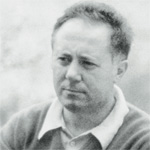Something useful?
Paolo Zanella came to the CERN computing group in 1962, just three years after the first computer had arrived. He later was head of the Data Handling Division for 13 years, before becoming professor at the University of Geneva.
 “When I came to CERN, my job was not only to find problems and solve them, but also to try and convince the physicists that computers were something useful. Only a few days after I arrived, Lew Kowarski, then leader of the Data Handling Division, sent me to see Carlo Rubbia, “a future Nobel Prize winner” in Kowarski's own words, to persuade him to use the recently installed IBM 709. Rubbia's welcome was that physicists did not need it and did not need me. But then he called me back and said that we should try this and try that — in the end, he was one of the first to adopt computer technology and used it widely and successfully in his experiments throughout his brilliant experimental work at CERN and elsewhere.
“When I came to CERN, my job was not only to find problems and solve them, but also to try and convince the physicists that computers were something useful. Only a few days after I arrived, Lew Kowarski, then leader of the Data Handling Division, sent me to see Carlo Rubbia, “a future Nobel Prize winner” in Kowarski's own words, to persuade him to use the recently installed IBM 709. Rubbia's welcome was that physicists did not need it and did not need me. But then he called me back and said that we should try this and try that — in the end, he was one of the first to adopt computer technology and used it widely and successfully in his experiments throughout his brilliant experimental work at CERN and elsewhere.
When I was appointed division leader in 1976 it was with an assignment to reverse trends. The division was in crisis. We had powerful but unreliable computers and some software disasters. The physicists were furious. But a few years later, they were pleased about the changes and the division had earned respect.
We provided excellent service and at the same time we did drive development in the field. However, the relationship with the researchers has never been easy. When we asked for money to develop networks in the 1970s they “could not see why two computers would be interested in talking to each other”, and later the cabling of buildings and the advent of workstations was strongly opposed. In the end, IT invaded the experimental floors, the engineers’ and administrators’ offices, and just at the end of my professional life at CERN, when the World Wide Web was invented, we were recognized as one of the best and most advanced IT environments in scientific research worldwide.
I learned a lot in my training at CERN — and not only technically. Here I got the courage to take on the impossible and to win. I lived during one of the most interesting half-centuries of particle physics — and now in biology, biomedicine, pharmaceutical research one encounters the same problems in integrating IT with experimental research. At CERN, I learned a few basic questions that work universally: What is it for? Why do we need it? Will it work? And if you make something useful that works, it will surely be praised and adopted.
In the 1960s, computing was there but nobody knew what to do with it. On the other side was science, and they had to come together step-by-step. Information technology is a universal machinery that can do a lot for science and for civilisation. In the last 50 years IT and particle physics have followed very similar growth curves pushing and changing each other. I have been very lucky to live most of my life at the frontier between these two exciting disciplines.”

